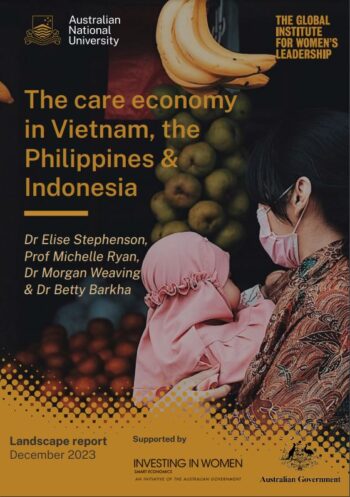Summary
This landscape study provides an overview of the care economy in Vietnam, the Philippines and Indonesia. It examines definitions of the care economy in each of the three countries and analyses key topics and findings from existing literature on the care economy. It also studies forums where care is discussed, the way care is discussed, and key actors who are carrying out work related to the care economy in the region. Lastly, the report identifies key research, policy and practice gaps that present opportunities to drive change.
Contents
- Definitions of the care economy in Vietnam, the Philippines and Indonesia
- Key research trends including:
- Effect of the care economy on women’s labour force participation
- Cultural and historical influences on the gendered division of care
- Increasing demand for care services
- Migration and the status of women in the formal care economy
- Generational shifts in gendered expectations of care work
- Use of policy interventions
- Key care economy actors and what they are doing: government, non-governmental organisations, international organisations, the private sector
- Key research, policy and practice gaps that present opportunities for interventions
- Shifting social norms
- Working with organisations to establish standards
- Encouraging government policy change
- Supporting individuals
Highlights
- Definitions of care and care systems remain under-developed, limiting the ability of countries to set policy and share common learnings.
- Women bear a disproportionate burden of unpaid care, which limits their ability to participate in the workforce. Care workers across Vietnam, the Philippines and Indonesia face low pay and poor working conditions, which impacts how informal carers are treated.
- There lacks a baseline mapping of care interventions and opportunities, including assessing effectiveness and experiences in the care economy.
- Interventions need to target structural and organisational impacts for systemic gains. It is also critical to embed intersectionality and sensitivity for historical precedents, cultural and religious norms.
- Four main actors involved in the provision of care and related research, policies and interventions are: government, non-government organisations (NGOs), international organisations, and the private sector.
- Key research, policy and practice gaps that present opportunities to drive change include: shifting social norms, working with organisations to establish standards, encouraging government policy change, and supporting individuals.

View other Resources
World Economic Forum Global Gender Gap 2024
The Global Gender Gap Index annually benchmarks the current state and evolution of gender parity.
Empowering Women Entrepreneurs in Southeast Asia
The report delves into the factors driving women’s economic participation and entrepreneurship across the region and provides recommendations on policy tools and best practices to unlock women’s full potential.
Women’s economic empowerment strategy
The “Women’s economic empowerment strategy” articulates UN Women’s vision for enabling women’s economic agency, autonomy, and well-being.

